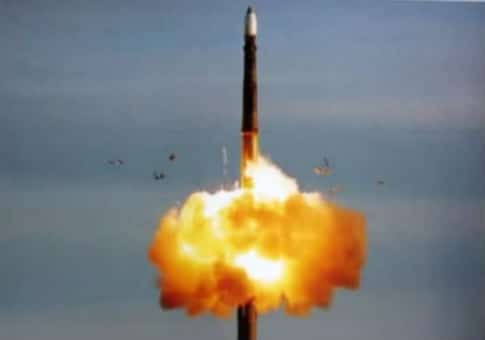The RS-26 Rubezh is a Russian solid-fueled, road-mobile intercontinental ballistic missile (ICBM) currently in development. Although classified as an ICBM under the New START Treaty, the RS-26 has been tested with heavier payloads at ranges below 5,500 km, potentially putting Russia in violation of the Intermediate-Range Nuclear Forces (INF) Treaty.
RS-26 Rubezh at a Glance
- Originated from
- Russia
- Possessed by
- Russia
- Alternate names
- SS-X-31, Frontier, Avangard, Yars-M, KY-26
- Class
- Intercontinental Ballistic Missile (ICBM) / Intermediate-Range Ballistic Missile (IRBM) [classification disputed]
- Basing
- Road-mobile
- Length
- 12 m
- Diameter
- 1.8 m
- Launch weight
- 36,000 kg
- Payload
- 800 kg
- Warhead
- Nuclear, single warhead or MIRV
- Propulsion
- Solid propellant
- Range
- 2,000-5,800 km
- Status
- In development

RS-26 Development
Development of the RS-26 began in 2008 by the Moscow Institute of Thermal Technology. It is reportedly based on the RS-24 Yars ICBM, although Russia has acknowledged that the RS-26 has fewer stages and a shorter range compared to the Yars.1
The RS-26’s first test launch, which ended in failure, occurred September 28, 2011 at the Plesetsk Cosmodrome. The missile veered off course and crashed eight kilometers from its launch site.2
In May 2012, a second test was reportedly successful. The missile travelled 5,800 km with a single, light-weight warhead. As a result of this flight test, the RS-26 was classified as an ICBM under the New START Treaty, which seeks to limit and reduce the number of strategic arms between the United States and Russia.
A subsequent test in October 2012, however, flew 2,000 km with a heavier payload from the Kapustin Yar testing range to Sary Shagan (located in southern Kazakhstan). All flight tests since have also been flown to medium-range distances (between 1,000 and 3,000 km). This has raised questions concerning Russia’s compliance with the INF Treaty, which forbids the deployment of missiles with ranges between 500-5,500 kilometers.3
An exhibition to U.S. inspectors was planned for November 2015. However, it was cancelled and rescheduled for 2016. It has since been postponed until 2017. There has been little activity to indicate plans are moving forward to officially deploy the missile.9
Specifications
The RS-26 is a solid-propellant, road-mobile ICBM. It is estimated to be 12 m long and 1.8 m in diameter. It is reportedly based on the RS-24 Yars ICBM, but its dimensions are also similar to the SLBM Bulava-30.10 It weighs 36,000 kg and carries an 800 kg nuclear warhead. It is currently unclear if the RS-26 carries a single warhead or multiple MIRVed warheads. Russia tested the missile with both payload configurations in 2013.
Footnotes
- Stefan Forss, “Russia’s New Intermediate Range Missiles – Back to the 1970s,” Atlantic Council, April 6, 2017, http://www.atlanticcouncil.org/blogs/natosource/russia-s-new-intermediate-range-missiles-back-to-the-1970s.
- “Russia Successfully Test-Fires RS-26 Ballistic Missiles,” Sputnik News, March 26, 2015, https://sputniknews.com/russia/201503261020029499/.
- Amy Woolf, “Russian Compliance with the Intermediate Range Nuclear Forces (INF) Treaty: Background and Issues for Congress,” CRS Report, March 15, 2017, 16-18, https://fas.org/sgp/crs/nuke/R43832.pdf.
- “Russian Missile Test Creates Confusion and Opposition in Washington,” Federation of American Scientists, July 3, 2013, https://fas.org/blogs/security/2013/07/yars-m/ ; “Too Many Missiles – Rubezh, Avangard, and Yars-M,” Russian Strategic Nuclear Forces, July 6, 2013, http://russianforces.org/blog/2013/07/too_many_missiles_-_rubezh_ava.shtml ; Amy F. Woolf, “Russian Compliance with the Intermediate Range Nuclear Forces (INF) Treaty: Background and Issues for Congress,” CRS Report, March 15, 2017, https://fas.org/sgp/crs/nuke/R43832.pdf.
- Ibid.
- Ibid.
- Ibid.
- “RS-26 Is Tested and Ready for Deployment,” Russian Strategic Nuclear Forces, March 26, 2015,http://russianforces.org/blog/2015/03/rs-26_is_tested_and_ready_for.shtml ; “Russia Successfully Test-fires RS-26 Ballistic Missile,” Sputnik News, March 26, 2015, https://sputniknews.com/russia/201503261020029499/ ; “Russia Again Flight Tests New ICBM to Treaty-Violating Range,” The Washington Free Beacon, March 31, 2015, http://freebeacon.com/national-security/russia-again-flight-tests-new-icbm-to-treaty-violating-range/.
- Pavel Podvig, “RS-26 and other intermediate-range ICBMs,” Russian Strategic Nuclear Forces, 2017, http://russianforces.org/blog/2017/07/rs-26_and_other_intermediate-r.shtml?utm_source=feedburner&utm_medium=feed&utm_campaign=Feed%3A+russianforces+%28RussianForces.org+Blog%29.
- Bill Gertz, “Russia Again Flight Tests New ICBM to Treaty-Violating Range,” The Washington Free Beacon, March 31, 2015, http://freebeacon.com/national-security/russia-again-flight-tests-new-icbm-to-treaty-violating-range/.